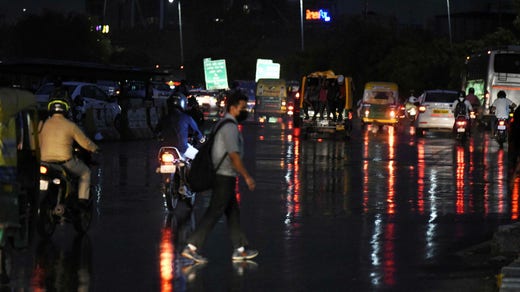In states such as Bihar and Assam in northern India and neighboring Bangladesh, several days of torrential rain have triggered floods and landslides and washed away schools, roads and railways. In Bangladesh, large areas of agricultural land have been inundated. At least 60 people were killed and several million forced from their homes in the densely populated countries. According to Indian media, the floods are the worst in decades at this time of year.
Delhi, with a population of 20 million, was hit by severe weather on Monday with torrential rains making access to parts of the city difficult. A large number of flights have been delayed or canceled. The rain also lowered the temperature by 11 degrees, from 30 degrees to just under 20 degrees.
– This morning when I woke up It rained so heavily that it was impossible to see the house across the street. I had to wait a few hours to go to work, the water didn’t run out and it wasn’t possible to get there by auto-rikshaw (three-wheeled taxi), says Suniti Virani by phone from New Delhi.
A few weeks ago, I described to DN how unbearable life was during a heat wave.

Sunite Virani.
Photo: Mia Holmgren
– At the moment, I think it is good that the heat has subsided, affected the mood and it was difficult to concentrate. It’s just a matter of spending the day, says Suniti Virani, who works in a beauty salon.
– But at the same time, nothing was natural this spring. The first was very, very, very hot and now it’s raining and thundering even though the monsoon hasn’t started. It feels like we are in a negative spiral.
last months Large parts of India experienced heat waves unlike any other. March was the warmest since measurements began 122 years ago. Last week, 49.2 degrees were recorded in parts of the capital, a hot record for May and well above normal.
Many people have had health problems. Energy consumption has also increased dramatically when air conditioners and fans are running at full speed. India, which is 70 percent dependent on electricity from coal-fired power plants, has therefore increased its carbon dioxide emissions.

Regnblöta gator i New Delhi.
Photo: Parveen Kumar / Hindustan Times / Shutterstock
According to climatologists at Indian Institute of Tropical Meteorology Pune, India and Bangladesh are particularly vulnerable to climate change due to their proximity to the tropical waters of the Indian Ocean and Bay of Bengal. Rising sea temperatures have led to “dry conditions” in some parts of the Indian subcontinent and a “significant increase in rainfall” in others. According to a study from Jan.
UN Climate Commission It also issued similar warnings of an increase in the number of severe heat waves and periods of drought.
two years ago The Indian Meteorological Department, IMD, has published a report showing an average temperature increase of 0.7 degrees since the beginning of the 20th century. If India fails to reduce carbon dioxide emissions, the number of annual heat waves is expected to triple by the end of the century. The report also warns that the number of hot nights during the year (when the temperature does not fall below 23 degrees) is expected to rise by 70 percent.
This year’s heat wave also affected neighboring Pakistan and the highest temperature was measured Jacobabad in Sindh Province Last weekend 51 degrees.

“Falls down a lot. Internet fanatic. Proud analyst. Creator. Wannabe music lover. Introvert. Tv aficionado.”



More Stories
More than 100 Republicans rule: Trump is unfit | World
Botkyrka Municipality suspends its directors after high-profile trip to New York
Huge asteroid approaching Earth | World